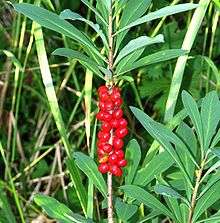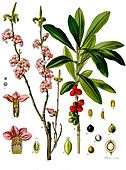Daphne mezereum
Daphne mezereum, commonly known as mezereum, mezereon,[2] February daphne, spurge laurel or spurge olive,[3] is a species of Daphne in the flowering plant family Thymelaeaceae, native to most of Europe and Western Asia, north to northern Scandinavia and Russia. In southern Europe it is confined to medium to higher elevations and in the subalpine vegetation zone, but descends to near sea level in northern Europe. It is generally confined to soils derived from limestone.
| Daphne mezereum | |
|---|---|
 | |
| Foliage and fruit | |
| Scientific classification | |
| Kingdom: | Plantae |
| Clade: | Tracheophytes |
| Clade: | Angiosperms |
| Clade: | Eudicots |
| Clade: | Rosids |
| Order: | Malvales |
| Family: | Thymelaeaceae |
| Genus: | Daphne |
| Species: | D. mezereum |
| Binomial name | |
| Daphne mezereum | |
It is a deciduous shrub growing to 1.5 m tall. The leaves are soft, 3–8 cm long and 1–2 cm broad, arranged spirally on the stems. The flowers are produced in early spring on the bare stems before the leaves appear. They have a four-lobed pink or light purple (rarely white) perianth 10–15 mm diameter, and are strongly scented. The fruit is a bright red berry 7–12 mm diameter; it is very poisonous for humans, though fruit-eating birds like thrushes are immune and eat them, dispersing the seeds in their droppings.
Toxicity
Daphne mezereum is very toxic because of the compounds mezerein and daphnin present especially in the berries and twigs. If poisoned, victims experience a choking sensation. Handling the fresh twigs can cause rashes and eczema in sensitive individuals. Despite this, it is commonly grown as an ornamental plant in gardens for its attractive flowers. The native wild version became a protected species in the UK in 1975 under the Conservation of Wild Creatures and Wild Plants Act.[4]
Symptoms of Poisoning
Ingestion of plant parts leads within a few hours to severe irritation and a burning sensation in the mouth, with swelling of the lips and face, increased salivation, hoarseness and difficulty in swallowing. These symptoms are soon followed by severe abdominal pain, headache, numbness, nausea and bloody diarrhoea. Children (who may be poisoned by the attractive red fruits) often show additional narcotic symptoms with muscular twitching. Work by Frohne and Pfänder has determined that it is the chewed seed, not the fruit pulp, that is responsible for the severe symptoms in poisoning by the berries.[5][6]
1955 Case study involving consumption of flowers
A seven year old boy, who was admitted to hospital (Department of Pediatrics, University Hospital Heidelberg) after consuming several flowers of D. mezereum (number unspecified) at first exhibited symptoms very similar to acute appendicitis, with headache and abdominal pain.[5]
...a number of neurologically and psychically striking symptoms developed in the hours that followed: periods of complete disorientation and very severe motor unrest alternated with periods of complete clarity, with tetanoid fearfulness. Towards evening, signs of meningitis and finally generalised convulsions appeared. Very severe diarrhoea then heralded serious enteritis which only subsided after a week.[7]
Gallery
- High detail
 In flower
In flower Close-up of flowers
Close-up of flowers- Toxic fruit
 White-flowered cultivar
White-flowered cultivar- Cultivated plant in flower in March
 Illustration of foliage and fruit
Illustration of foliage and fruit
Notes
- "Daphne mezereum". The Plant List. Retrieved 2017-11-19.
- "BSBI List 2007". Botanical Society of Britain and Ireland. Archived from the original (xls) on 2015-01-25. Retrieved 2014-10-17.
- Nelson, Lewis S.; Weil, Andrew; Goldfrank, L.R.; Shih, Richard D.; Balick, Michael J. Handbook of Poisonous and Injurious Plants. New York: Springer. p. 144. ISBN 0-387-31268-4. Retrieved 21 October 2014.
- http://www.caithness.org/caithnessfieldclub/bulletins/1975/october/conservation.htm
- A Colour Atlas of Poisonous Plants : A Handbook for Pharmacists, Doctors, Toxicologists, and Biologists by Frohne, Dietrich and Pfänder, Hans Jürgen of University of Kiel, translated from second German edition by Norman Grainger Bisset, London : a Wolfe Science Book and one of the volumes in the illustrated series Wolfe Atlases, pub. Wolfe Publishing Ltd. 1984. Pages 226-229.
- Lutz Roth, Max Daunderer, Karl Kormann: Giftpflanzen Pflanzengifte. 6. überarbeitete Auflage. Nikol, Hamburg 2012, ISBN 978-3-86820-009-6.
- Nöller, H.G. 'Ein Seidelbastintoxikation beim Kinde' Monatschr. Kinderheilk. 103, 327-330 (1955). (Translation: 'Poisoning of a child by Daphne mezereum' Monthly Bulletin of Paediatrics no. 103.)
References
- This article is based on a translation of an article from the German Wikipedia.
- Manfred A. Fischer: Exkursionsflora von Österreich, Stuttgart 1994, ISBN 3-8001-3461-6
- Smeil, Fitschen: Flora von Deutschland, Heidelberg, Wiesbaden.
External links
| Wikimedia Commons has media related to Daphne mezereum. |